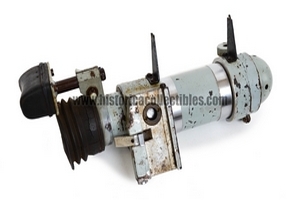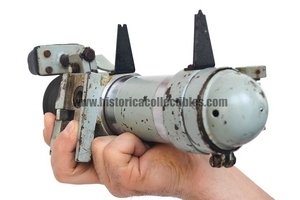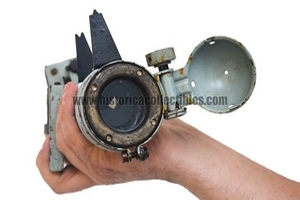Zieloptik U-Boot Kriegsmarine Ausf M44 DOK 1x40° (37 mm Flak M 42), circa 1944
Aiming sight mounted on 37 mm flak guns installed on Kriegsmarine submarines (U-boats). This type of optic, given the particular type of reticle with which it was equipped, was mainly used for anti-aircraft fire.
The peculiarity of this optic is found in its structure, completely made of solid brass, as it is designed to maintain a watertight seal (same principle as the UDF 7x50 binoculars) so that it never has to be removed from its installation and is always ready for use.
On the plate where there is the lever for quick removal and insertion, we find the number and the letter "D 231" and right below, clearly visible, the "WaA - Waffenamt" with the relative number, which, through this, it is possible to trace to the manufacturer. Under it we find that round slot designed to let light penetrate to illuminate the reticle using a special illuminator. The view is very clear and all the mechanisms work perfectly.
The optics feature anti-reflection treatment, a system developed and patented on November 1, 1935 by Aleksander Smakula, a member of the Zeiss staff in Jena since 1934.
There is its nameplate which shows the technical data of the optics and the manufacturer: "DOK 1x40° M44 - Ausf A - dow 584" or "Druckdichtes Optisches Kreiskorn (Pressure-tight optics) - WaffenwerkeBruenn, Prerau plant, Czechoslovakia" ( renamed "Opticotechna GmbH, Werk Prerau / Protektorat" 1943).
Its total weight is 3 kg.
Heereswaffenamt (sometimes written WaffenAmt, abbreviated to WaA) is the name given to the armaments agency of the Reich army in Germany between the two world wars, organized into a center for research and development of war potential - weapons, ammunition and military forces.
Founded on 8 November 1919 as the Waffenamt, it changed its name on 5 May 1922 to the Heereswaffenamt.
It is the body that issued the manufacturing patent for the Walther P38 pistol.
Waffenamt codes is the name given to verification visas issued at the end of material inspections.
The task of supervising Germany's gigantic rearmament process on the eve of the Second World War was entrusted to the Heeresabnahmestelle, a section of the army also known as Abnahme and created as a function of the Heereswaffenamt.
In the year 1940 the Abnahme numbered twenty-five thousand personnel, divided into five departments and sixteen inspection areas, supplemented by specially selected local personnel assigned to assist the Waffenamt inspectors during the verification of the artefacts. In mid-1944 approximately eight thousand of the Abnahme inspectors were disengaged from the agency to be sent to the war fronts.
Responsible for the verification and acceptance of all types of weapons, equipment, ammunition ready for distribution to the Wehrmacht was the Heeres-Abnahmewesen. The tests on the materials were conducted according to detailed protocols prepared by the various Waffenprufamter (WaPruf) departments and called Technische Lieferbedingungen (TLs).
Already at the beginning of 1935, with the transition from the Reichswehr to the Wehrmacht, the Waffenamt officers assigned to inspections as part of the rearmament program were subjected to a particular technical qualification program.
When the final phase of the rearmament program reached its culmination, the inspection departments of the Waffenamt began to operate throughout the territory, positioning themselves in each war company active in Germany and whose owners were urged to increase industrial production.
In view of the new production commitment, a four-week course was organized for the benefit of industrialists in the sector at the Heereswaffenmeisterschule, a real school for manufacturers of war instruments. At the end of the course, a test took place to which the technical inspectors were subjected who, by passing it, could improve their hierarchical position and reach the rank of Oberleutnant (lieutenant). The approaching start of the world war (in 1939) guaranteed them an early completion of training and a promotion to the rank of first class technical inspector, equivalent to the rank of Hauptmann (captain).







